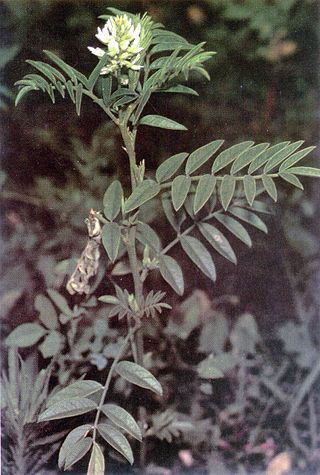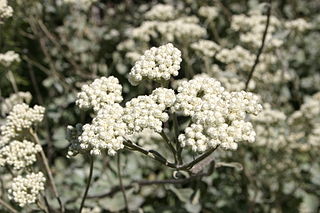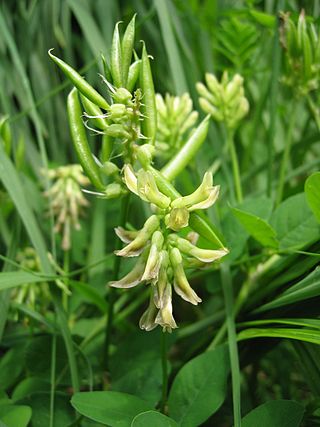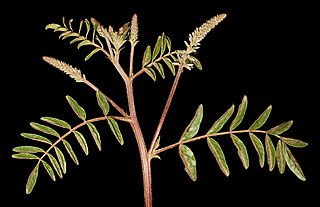
Liquorice or licorice is the common name of Glycyrrhiza glabra, a flowering plant of the bean family Fabaceae, from the root of which a sweet, aromatic flavouring is extracted.

Glycyrrhizin is the chief sweet-tasting constituent of Glycyrrhiza glabra (liquorice) root. Structurally, it is a saponin used as an emulsifier and gel-forming agent in foodstuffs and cosmetics. Its aglycone is enoxolone.

Glycyrrhiza is a genus of about 20 accepted species in the legume family (Fabaceae), with a subcosmopolitan distribution in Asia, Australia, Europe, and the Americas.

Glycyrrhiza lepidota is a species of Glycyrrhiza native to most of North America, from central Canada south through the United States to California, Texas and Virginia, but absent from the southeastern states. It is also sometimes known in the United States as "wild licorice", to distinguish it from the related European licorice which is occasionally cultivated.

Liquorice or licorice is a confection usually flavoured and coloured black with the extract of the roots of the liquorice plant Glycyrrhiza glabra. A wide variety of liquorice sweets are produced around the world. In North America, black liquorice is distinguished from similar confectionery varieties that do not contain liquorice extract but are manufactured in the form of similarly shaped chewy ropes or tubes and often called red liquorice. Black liquorice, together with anise extract, is also a common flavour in other forms of confectionery such as jellybeans. In addition to these, various other liquorice-based sweets are sold in the United Kingdom, such as liquorice allsorts. In addition to the sweet variations typically found in the United Kingdom and North America, Dutch, German and Nordic liquorice characteristically contains ammonium chloride instead of sodium chloride, prominently so in salty liquorice, which carries a strong salty rather than sweet flavor.

Helichrysum petiolare, the licorice-plant or liquorice plant, is a species of flowering plant in the family Asteraceae, native to South Africa — where it is known as imphepho — and naturalized in parts of Portugal and the United States. Growing to about 45 cm (18 in) high and 150 cm (59 in) broad, it is a trailing evergreen subshrub with furry grey-green leaves and small white flowers. Other common names include silver-bush everlastingflower, trailing dusty miller and kooigoed. The foliage has a faint licorice aroma, but Helichrysum petiolare is not closely related to the true liquorice plant, Glycyrrhiza glabra.

Glycyrrhiza uralensis, also known as Chinese liquorice, is a flowering plant native to Asia. It is used as a sweetener and in traditional Chinese medicine.

Astragalus glycyphyllos is a flowering plant in the family Fabaceae, native to Europe. It is a perennial herbaceous plant which is sometimes used for tea.

Polypodium vulgare, the common polypody, is an evergreen fern of the family Polypodiaceae. Polypodium vulgare is an allotetraploid species, believed to have arisen by chromosome doubling of a sterile diploid hybrid between two ferns which are not known in Europe. The fern's proposed parents are the northern Asian and northern North American Polypodium sibiricum and western North American Polypodium glycyrrhiza. Biochemical data point to a species from eastern Asia as the second possible parent. The name is derived from poly (many) and pous, podos . Polypody has traditional uses in cooking for its aroma and sweet taste, and in herbal medicine as a purgative and vermifuge.

Polypodium glycyrrhiza, commonly known as licorice fern, many-footed fern, and sweet root, is a summer deciduous fern native to western North America, where it is found in shaded, damp locations.
The molecular formula C20H18O4 may refer to:
Glycyrrhiza inflata is a plant species in the genus Glycyrrhiza from China, with common name Chinese licorice. A related species, G. uralensis, however, is more likely the licorice species one finds in traditional Chinese medicine.

Glycyrrhiza acanthocarpa, with the common names native liquorice, and southern liquorice is a subshrub in the pea family, Fabaceae. The species is native to Australia. It grows to between 0.1 and 1 metre high. Narrow purple flowers appear between September and May in the species native range.

Liquiritigenin is a flavanone that was isolated from Glycyrrhiza uralensis, and is found in a variety of plants of the Glycyrrhiza genus, including Glycyrrhiza glabra (licorice). It is an estrogenic compound which acts as a selective agonist of the ERβ subtype of the estrogen receptor (ER), though it is also reported to act as an ERα partial agonist at sufficient concentrations. It also has a choleretic effect.
Licorice plant is a common name for several plants and may refer to:
Liquorice or licorice is the root of Glycyrrhiza glabra from which a somewhat sweet flavor can be extracted.

Glycyrrhiza echinata is a species of flowering plant in the genus Glycyrrhiza, with various common names that include Chinese licorice, German licorice, and hedgehog licorice, Eastern European licorice, Hungarian licorice, Prickly licorice, and Roman licorice. It is used as a flavoring and medicinally, and to produce Russian and German licorice.

Galium lanceolatum, commonly known as lanceleaf wild licorice or Torrey's wild licorice, is a species of flowering plant native to the eastern temperate regions of North America. The name 'wild licorice' comes from the species' taste, similar to that of true licorice.













